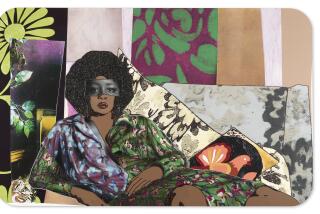A Minute Look at Monumental Process
When we think of Christo, we think of the grand gesture: Berlin’s Reichstag wrapped in acres of silver mesh; thousands of golden umbrellas landing like dandelion spores on the hills along the California Grapevine; islands in Florida’s Biscayne Bay encircled by broad, floating necklaces of pink. Christo--together with his wife and working partner, Jeanne-Claude--is a phenomenon, a stager of spectacles, the Cecil B. DeMille of the art world.
What goes on behind the scenes to make these monumental projects happen is also considered by the artists a part of the works. The negotiating, sketching, mapping, planning, and permitting processes are intensive. The wrapping of the Reichstag took an arduous 24 years to bring to fruition. These are complicated feats not just of physical engineering, but also of political and financial strategy. They are wild, conceptual dreams labored into sensual reality.
The artists’ work, then, is a matter of indoor prep and outdoor extravaganza. Exhibitions of their work, however, can accommodate only one of these--and it’s not the one with the glamour and pizazz. A current effort, “Christo and Jeanne-Claude in the Vogel Collection From the National Gallery of Art,” does a responsible job surveying 40 years of work, primarily through the preparatory process and its material evidence: drawings, collages, photographs and sculptures. The show, at the Museum of Contemporary Art, San Diego, is broad enough and informative. Several early sculptures even deliver a visceral thrill, but the preparatory works remain just that--preparatory and secondary. They don’t generate the enthusiasm of the realized projects any more than an architectural model can match the physical impact of a built structure, or a score on paper can penetrate as deeply as the music played. That said, the show has its high points, and together with a companion exhibition provides a solid introduction to Christo and Jeanne-Claude’s work.
The National Gallery show, organized by curator Molly Donovan, is supplemented in San Diego (its only other stop) by an exhibition of Christo’s work from the extensive collection of MCA trustee David C. Copley. (Copley’s collection is a promised gift to the museum.) The two shows overlap considerably in content, so their separate installation does little for continuity or chronology. Each show, though, helps flesh out the other, as do additional works from MCA’s collection.
Over the decades, Christo has evolved into an art celebrity known on a first-name-only basis, but his origins were far humbler and his initial bent more subversive. He fled his native Bulgaria, discontent with Communist rule there, at age 21, and settled, after brief stays elsewhere, in Paris in the late 1950s. One of his first publicly staged actions consisted of blocking off a small Parisian street with a wall of oil barrels, a piece he called “The Iron Curtain” (1961-62).
At the time, he was supporting himself by painting portraits, and in 1963, he took a painting he had made of Jeanne-Claude and wrapped it in a sheer material. Her face shows through but is veiled the way the body is veiled by lingerie. This stunning and important early work from the Copley Collection is matched in the Vogel show by several landmark sculptures Christo made in the early ‘60s by wrapping unknown objects in tarpaulins and twine.
Christo and Jeanne-Claude refer to their monumental outdoor works as “gentle disturbances.” These early mysterious bundles of Christo’s operate similarly, upsetting the conventional relationship between art object and viewer. The wrapping is a ploy, a promise, a paradox. It makes unviewable whatever is beneath the tarps, even as the object’s sole function, as sculpture, is to be viewed. These remarkable early sculptures nod to Duchamp, and evoke as well a Surrealist sense of poetic displacement that captivated Christo early on. As an exile, and something of a nomad (the artists moved to New York in 1964, but continue to work internationally), displacement remains an undercurrent.
The technique of wrapping also resonated well with the Pop era’s preoccupation with consumer culture and the politics of display. Such latent meanings seem largely to fall away, however, as the work expanded to grand, environmental scale, beginning with the one-million- square-foot “Wrapped Coast” in Sydney, Australia. Temporary gestures of spectacular drama, the environmental works are Christo’s audacious answer to the oppressive system he grew up under in Bulgaria. Through the work, he flaunts his freedom from social or political imperatives. He and Jeanne-Claude have refused outside sponsorship; they sell preparatory works like those in the exhibition to fund the large-scale projects.
The outdoor works all engage boundaries of some sort, whether in the form of wrapping (the Reichstag, Pont Neuf, a grove of trees) or installing a fence (“Running Fence” 1972), a curtain (“Valley Curtain” 1970-72) or a canopy, as in a project planned for the Arkansas River in Colorado. Using fluid, vibrant fabrics, Christo and Jeanne-Claude evoke skin and its coverings, aligning their work with the long art history of draped fabric more consistently than with any particular style or school.
Outrageous physicality is what excites about Christo and Jeanne-Claude’s work. The drawings, collages and photographs here are well-executed, and all make a valiant effort to convey that essential relationship of viewer to place, but scale, time and movement are missing. Without these, the work’s core appeal remains under wraps.
Museum of Contemporary Art, San Diego, 700 Prospect St., La Jolla. (858) 454-3541. Through Jan. 5. Closed Wednesdays.
More to Read
The biggest entertainment stories
Get our big stories about Hollywood, film, television, music, arts, culture and more right in your inbox as soon as they publish.
You may occasionally receive promotional content from the Los Angeles Times.










